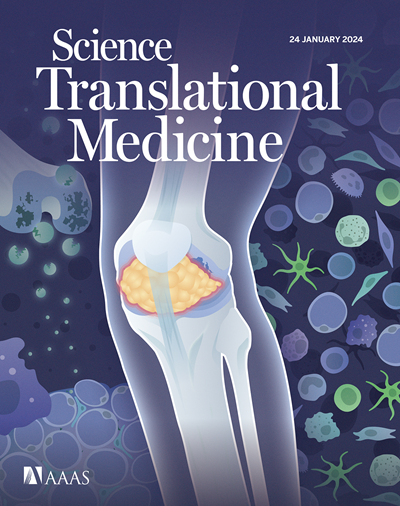在临床前模型中使用改良的人偶弹力蛋白基密封剂快速关闭和止血破裂的软组织
IF 15.8
1区 医学
Q1 CELL BIOLOGY
引用次数: 0
摘要
软弹性器官损伤的治疗常常受到具有挑战性的解剖特征和现有密封材料的局限性的阻碍,这些材料可能缺乏足够的组织粘附性、弹性、生物相容性和有效的止血性能。为了解决这些临床挑战,我们开发了一种可注射的弹性密封剂,该密封剂由甲基丙烯酰修饰的重组人弹力蛋白(MeTro)和硅酸钙纳米血小板(SNs)组成。我们优化了水凝胶配方的机械性能、粘附性、生物相容性和止血性能,并利用可见光进行交联以提高安全性。与MeTro单独或商用密封剂相比,MeTro/SN水凝胶在体外和离体均增加了组织粘附强度和破裂压力。在水凝胶中加入SNs可以加快体外凝血速度,但不会增加溶血。应用于大鼠肺或主动脉的切口损伤,MeTro/SN在体内应用7天后,其破裂压力与天然组织相当,高于MeTro。在猪肺中,MeTro/SN在损伤闭合后14天也支持有效的肺密封和与天然肺相似的破裂压力。在啮齿动物尾部止血模型中,与MeTro相比,MeTro/SN可减少出血。在猪肺损伤模型中,早期止血效果优于商用密封胶。结果表明,MeTro/SN提供了有效的组织密封,并在一定时间内促进止血,最大限度地减少失血,而不会引起严重的炎症反应。这些发现突出了我们的工程密封胶的转化潜力,它具有仿生力学、持久的组织粘连和快速止血的特点,是一种多管齐下的软器官创伤密封和修复方法。本文章由计算机程序翻译,如有差异,请以英文原文为准。
Rapid closure and hemostasis of ruptured soft tissues using a modified human tropoelastin-based sealant in preclinical models
Treatment of injuries to soft elastic organs is often hindered by challenging anatomical features and limitations of existing sealant materials, which may lack adequate tissue adhesion, elasticity, biocompatibility, and effective hemostatic properties. To address these clinical challenges, we developed an injectable elastic sealant formulated with methacryloyl-modified human recombinant tropoelastin (MeTro) and Laponite silicate nanoplatelets (SNs). We optimized the hydrogel formulation for mechanical properties, adhesion, biocompatibility, and hemostatic properties and used visible light for cross-linking to improve safety. MeTro/SN hydrogels had increased tissue adhesion strength and burst pressure in vitro and ex vivo compared with MeTro alone or commercial sealants. The addition of SNs to the hydrogels facilitated faster blood clotting in vitro without increasing hemolysis. Applied to incisional injuries on rat lungs or aortas, MeTro/SN had burst pressures comparable to those of native tissue and greater than those of MeTro after a 7-day in vivo application. On porcine lungs, MeTro/SN also supported effective lung sealing and burst pressure similar to native lung 14 days after injury sealing. In a rodent tail hemostasis model, MeTro/SN reduced bleeding compared with MeTro. In an injured porcine lung model, early hemostasis was better than the tested commercial sealants. The results demonstrated that MeTro/SN provided effective tissue sealing and promoted hemostasis in a time frame that minimized blood loss without causing a major inflammatory response. These findings highlight the translational potential of our engineered sealant with biomimetic mechanics, durable tissue adhesion, and rapid hemostasis as a multipronged approach for the sealing and repair of traumatic injuries to soft organs.
求助全文
通过发布文献求助,成功后即可免费获取论文全文。
去求助
来源期刊

Science Translational Medicine
CELL BIOLOGY-MEDICINE, RESEARCH & EXPERIMENTAL
CiteScore
26.70
自引率
1.20%
发文量
309
审稿时长
1.7 months
期刊介绍:
Science Translational Medicine is an online journal that focuses on publishing research at the intersection of science, engineering, and medicine. The goal of the journal is to promote human health by providing a platform for researchers from various disciplines to communicate their latest advancements in biomedical, translational, and clinical research.
The journal aims to address the slow translation of scientific knowledge into effective treatments and health measures. It publishes articles that fill the knowledge gaps between preclinical research and medical applications, with a focus on accelerating the translation of knowledge into new ways of preventing, diagnosing, and treating human diseases.
The scope of Science Translational Medicine includes various areas such as cardiovascular disease, immunology/vaccines, metabolism/diabetes/obesity, neuroscience/neurology/psychiatry, cancer, infectious diseases, policy, behavior, bioengineering, chemical genomics/drug discovery, imaging, applied physical sciences, medical nanotechnology, drug delivery, biomarkers, gene therapy/regenerative medicine, toxicology and pharmacokinetics, data mining, cell culture, animal and human studies, medical informatics, and other interdisciplinary approaches to medicine.
The target audience of the journal includes researchers and management in academia, government, and the biotechnology and pharmaceutical industries. It is also relevant to physician scientists, regulators, policy makers, investors, business developers, and funding agencies.
 求助内容:
求助内容: 应助结果提醒方式:
应助结果提醒方式:


